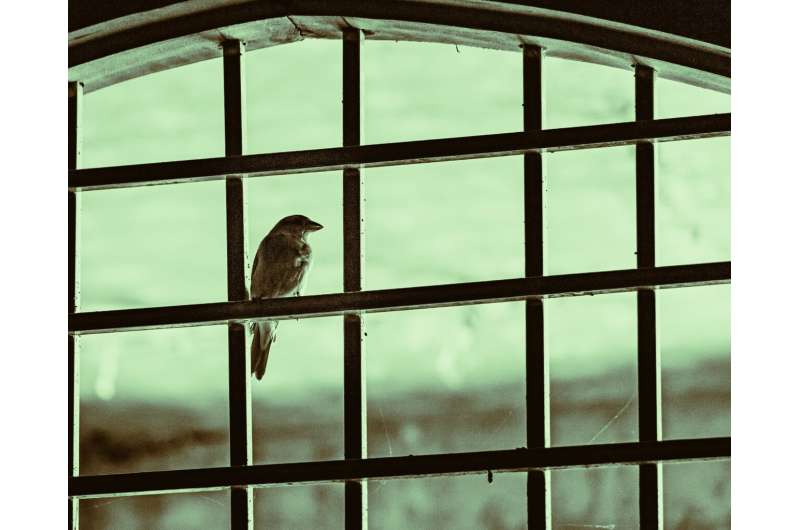This article has been reviewed according to Science X's editorial process and policies. Editors have highlighted the following attributes while ensuring the content's credibility:
fact-checked
trusted source
proofread
Q&A: Do we need a new approach to prevent bird window strikes?

In early October, nearly 1,000 birds perished after colliding with the windows of a convention center near Lake Michigan in Chicago, marking the largest mass bird die-off in decades. But bird window-strike fatalities are an ongoing threat. Illinois Natural History Survey wildlife ecologist Thomas J. Benson, an expert in bird population trends in Illinois, spoke to News Bureau life sciences editor Diana Yates about the problem and what new strategies may help.
How many birds die each year after colliding with windows? Are some species more susceptible than others?
The best estimate for the United States is somewhere between 400 million and 1 billion birds per year. Species do appear to vary in susceptibility, with many migratory species such as warblers and thrushes commonly found during spring and fall migration. Resident birds, such as cardinals, blue jays and many woodpeckers also do collide with buildings, but they're often not found in the same numbers as the migratory birds.
Do bird window strikes occur more often at certain times of year?
Window strikes occur all year but appear to be most common during spring and fall migrations. In many places, the mortality in fall is roughly twice that seen in spring, presumably because of the large number of young birds produced during the summer months that are making their first migration in fall.
Are some types of buildings more prone to bird strikes than others?
Tall buildings are generally seen as a greater hazard than shorter buildings, and those that keep their lights on at night are especially prone to bird strikes. That said, the cumulative effect of tall buildings on bird-strike mortalities is less than those occurring with mid-sized commercial and residential buildings or single-family homes given the much larger number of these smaller buildings.
What kinds of architectural details can lessen—or increase—the potential hazards for birds?
The top predictors of bird collisions are generally the amount of glass on a particular building or façade and the presence of light at night. Collisions generally occur at night or early in the morning. At those times, birds mistake window reflections of the sky or trees as actual sky or trees—and they collide with them.
Birds are attracted to the light at night—also increasing the number of window strikes. The configuration of windows can also make a difference. For example, alcoves or parts of buildings that project out from the main structure and have lots of windows can be especially problematic. One example of this on our campus is the glass on the south side of the Beckman Institute. This is likely the top place for bird-strike mortality on our campus.
Conservationists have spent decades promoting measures to reduce bird collisions with windows. Why are we still seeing so many bird window-strike fatalities?
We love having windows that expose us to natural light and allow us to see outdoors, so designing buildings with fewer windows is unlikely to be an acceptable solution. We're starting to understand how to build and use windows that are better perceived as a hazard to birds, such as using patterned glass or incorporating ultraviolet reflectance, as many birds can see in the UV range. Some states, Including Illinois, have recently enacted laws requiring bird-friendly designs be used during the construction or renovation of state-owned buildings.
What other strategies work best to prevent bird collisions with windows?
In addition to using bird-friendly glass, there are after-market products that add subtle patterning to existing windows that make them more apparent to birds. Recent research at Oklahoma State University has demonstrated that these products are effective for decreasing collisions. Given the known influence of lighted windows at night, efforts to decrease building lights during periods of bird migration can be effective.
Some recent efforts use radar-based data to track the intensity of bird migration to generate lights-out notifications on nights of particularly intense bird migration. One of the scientists helping lead this research, Benjamin Van Doren, will join the U. of I. faculty this year.
Do you think the recent mass die-off at the Chicago convention center will lead to a greater sense of urgency about the problem?
I do believe it has increased awareness of the problem, but it's important to understand that the problem is not restricted to some large buildings in Chicago. Students at the U. of I., including past and current members of the student chapter of the Wildlife Society on campus, have recorded hundreds of bird deaths per year involving just nine buildings on our campus.*
Similar work on other campuses such as Duke and Oklahoma State has led to actions to retrofit windows in problematic buildings. These efforts demonstrate that, with appropriate resources, this is a manageable problem. We're not going to eliminate bird window strikes, but we can substantially reduce them.
What can homeowners do to reduce bird window strikes?
Applying window treatments and being conscious of nighttime lighting during migration periods can help reduce window strikes. There are many great online resources with additional information, including this one from the Cornell Lab of Ornithology.
Provided by University of Illinois at Urbana-Champaign




















